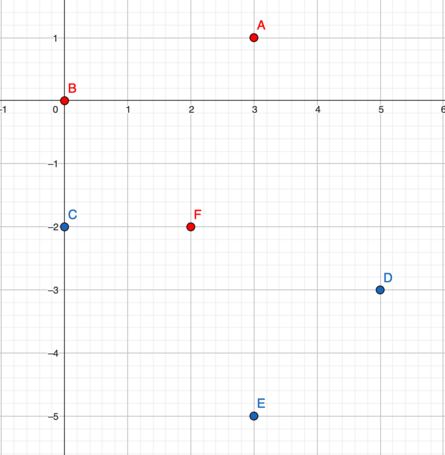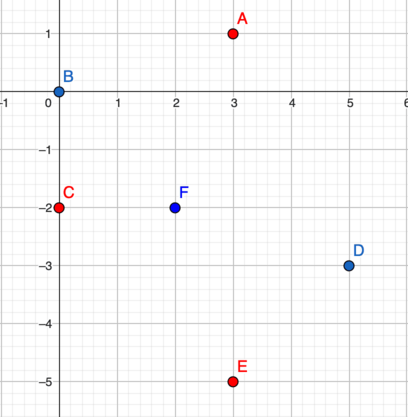| Codeforces Round 951 (Div. 2) |
|---|
| Finished |
The Manhattan distance between two points $$$(x_1, y_1)$$$ and $$$(x_2, y_2)$$$ is defined as: $$$$$$|x_1 - x_2| + |y_1 - y_2|.$$$$$$
We call a Manhattan triangle three points on the plane, the Manhattan distances between each pair of which are equal.
You are given a set of pairwise distinct points and an even integer $$$d$$$. Your task is to find any Manhattan triangle, composed of three distinct points from the given set, where the Manhattan distance between any pair of vertices is equal to $$$d$$$.
Each test consists of multiple test cases. The first line contains one integer $$$t$$$ ($$$1 \le t \le 10^4$$$) — the number of test cases. The description of the test cases follows.
The first line of each test case contains two integers $$$n$$$ and $$$d$$$ ($$$3 \le n \le 2 \cdot 10^5$$$, $$$2 \le d \le 4 \cdot 10^5$$$, $$$d$$$ is even) — the number of points and the required Manhattan distance between the vertices of the triangle.
The $$$(i + 1)$$$-th line of each test case contains two integers $$$x_i$$$ and $$$y_i$$$ ($$$-10^5 \le x_i, y_i \le 10^5$$$) — the coordinates of the $$$i$$$-th point. It is guaranteed that all points are pairwise distinct.
It is guaranteed that the sum of $$$n$$$ over all test cases does not exceed $$$2 \cdot 10^5$$$.
For each test case, output three distinct integers $$$i$$$, $$$j$$$, and $$$k$$$ ($$$1 \le i,j,k \le n$$$) — the indices of the points forming the Manhattan triangle. If there is no solution, output "$$$0\ 0\ 0$$$" (without quotes).
If there are multiple solutions, output any of them.
66 43 10 00 -25 -33 -52 -25 40 00 -25 -33 -52 -26 63 10 00 -25 -33 -52 -24 43 00 3-3 00 -310 82 1-5 -1-4 -1-5 -30 1-2 5-4 4-4 20 0-4 14 400000100000 100000-100000 100000100000 -100000-100000 -100000
2 6 1 4 3 5 3 5 1 0 0 0 6 1 3 0 0 0
In the first test case:
 Points $$$A$$$, $$$B$$$, and $$$F$$$ form a Manhattan triangle, the Manhattan distance between each pair of vertices is $$$4$$$. Points $$$D$$$, $$$E$$$, and $$$F$$$ can also be the answer.
Points $$$A$$$, $$$B$$$, and $$$F$$$ form a Manhattan triangle, the Manhattan distance between each pair of vertices is $$$4$$$. Points $$$D$$$, $$$E$$$, and $$$F$$$ can also be the answer. In the third test case:
 Points $$$A$$$, $$$C$$$, and $$$E$$$ form a Manhattan triangle, the Manhattan distance between each pair of vertices is $$$6$$$.
Points $$$A$$$, $$$C$$$, and $$$E$$$ form a Manhattan triangle, the Manhattan distance between each pair of vertices is $$$6$$$. In the fourth test case, there are no two points with a Manhattan distance of $$$4$$$, and therefore there is no suitable Manhattan triangle.
| Name |
|---|




